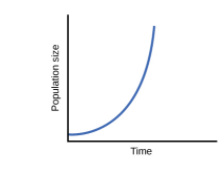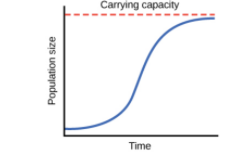
Compare, giving reasons, the J-shaped and S-shaped models of population growth of a species.
Answer
585.6k+ views
Hint: The J-shaped curve is seen in the case when there are unlimited resources in the environment but the S-shaped curve is seen when the resources are limited. Also, the second one involves a stationary phase which is not a part of the first one.
Complete answer:
The J-shaped curve is obtained in the case of exponential growth. For this type of growth, the suitable condition is the availability of unlimited resources in the environment in which the population lives. Here, the unlimited resources mean unlimited food and land so that the population can grow with its maximum fertility capacity. This is practically not possible because in our environment the resources are not limited for any population or species. This is the reason that this type of growth curve is shown only by the microorganisms that are grown in the culture media with the unlimited supply of nutrients. A J-shaped growth curve has been shown below –

The S-shaped curve is obtained in the case of logistic growth. This type of growth curve is more practical than the J-shaped and is shown by the organisms living in a natural environment. As the resources are limited in the environment, the growth rate varies with respect to time. Initially, the growth is comparatively slower but later it shows a sharp increase and when it reaches near the carrying capacity of the environment, it becomes too slow because at this point the population has consumed maximum available resources. An S-shaped curve looks like –

Note:There are two phases in the exponential growth, first one is the lag phase and the second one is the log phase but in the logistic growth, there are four phases as lag phase, log phase, deceleration phase, and stationary phase.
>Carrying capacity of the environment is not considered in the case of exponential growth but it serves as an important factor in the case of logistic growth.
Complete answer:
The J-shaped curve is obtained in the case of exponential growth. For this type of growth, the suitable condition is the availability of unlimited resources in the environment in which the population lives. Here, the unlimited resources mean unlimited food and land so that the population can grow with its maximum fertility capacity. This is practically not possible because in our environment the resources are not limited for any population or species. This is the reason that this type of growth curve is shown only by the microorganisms that are grown in the culture media with the unlimited supply of nutrients. A J-shaped growth curve has been shown below –

The S-shaped curve is obtained in the case of logistic growth. This type of growth curve is more practical than the J-shaped and is shown by the organisms living in a natural environment. As the resources are limited in the environment, the growth rate varies with respect to time. Initially, the growth is comparatively slower but later it shows a sharp increase and when it reaches near the carrying capacity of the environment, it becomes too slow because at this point the population has consumed maximum available resources. An S-shaped curve looks like –

Note:There are two phases in the exponential growth, first one is the lag phase and the second one is the log phase but in the logistic growth, there are four phases as lag phase, log phase, deceleration phase, and stationary phase.
>Carrying capacity of the environment is not considered in the case of exponential growth but it serves as an important factor in the case of logistic growth.
Recently Updated Pages
Why are manures considered better than fertilizers class 11 biology CBSE

Find the coordinates of the midpoint of the line segment class 11 maths CBSE

Distinguish between static friction limiting friction class 11 physics CBSE

The Chairman of the constituent Assembly was A Jawaharlal class 11 social science CBSE

The first National Commission on Labour NCL submitted class 11 social science CBSE

Number of all subshell of n + l 7 is A 4 B 5 C 6 D class 11 chemistry CBSE

Trending doubts
Differentiate between an exothermic and an endothermic class 11 chemistry CBSE

10 examples of friction in our daily life

One Metric ton is equal to kg A 10000 B 1000 C 100 class 11 physics CBSE

Difference Between Prokaryotic Cells and Eukaryotic Cells

1 Quintal is equal to a 110 kg b 10 kg c 100kg d 1000 class 11 physics CBSE

State the laws of reflection of light




